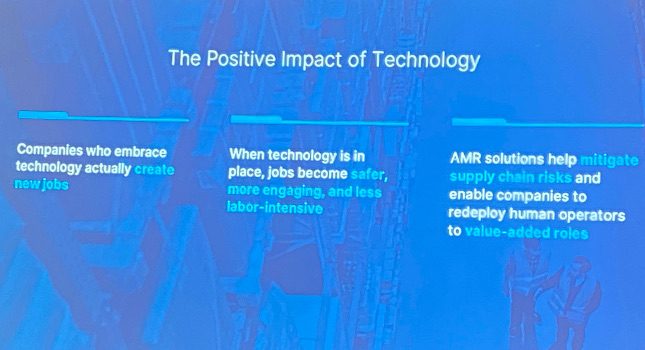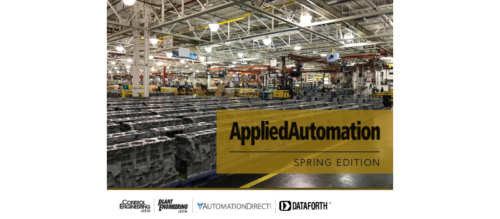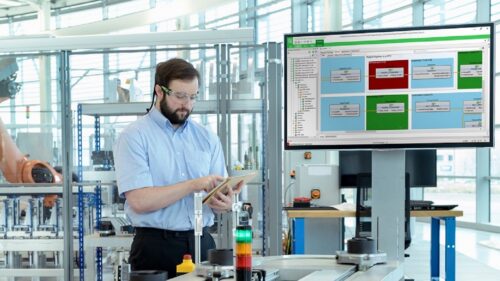Automation can help manufacturers, workers thrive
The growing need for skilled workers and increased automation should be a joint venture that can provide benefits for the company and employees.
Manufacturing has been dealing with several challenges due to the COVID-19 pandemic changing the way we live and purchase things, and automation is helping. The pandemic created a shift toward e-commerce while also creating an even greater vacuum as older workers retire.
While this is a challenge many manufacturers face, automation and autonomous mobile robots (AMRs) can help address the problem, said Todd Graves, CTO of Seegrid, in his presentation “AMRs and the Human Workforce: Working Together for a Future-Proof Partnership” at Automate in Detroit, a show and conference coordinated by the Association to Advance Automation (A3).
Graves said the COVID-19 pandemic created supply chain problems, resulting in fluctuating order volumes, heightened consumer expectations due to e-commerce and labor shortages.
“Companies are working to reduce the distance of where items are being distributed and putting them close to the consumer,” Graves said.

Todd Graves, CTO of Seegrid, in his presentation “AMRs and the Human Workforce: Working Together for a Future-Proof Partnership” at Automate in Detroit, a show and conference coordinated by the Association to Advance Automation (A3). Courtesy: Chris Vavra, CFE Media and Technology
Millennial, Gen-Z worker expectations
This has resulted in a lot of labor demand for the new factories—or it would, but it simply isn’t there, Graves said. Many older workers are retiring and taking their knowledge base with them. The problem is compounded because younger workers—millennials and Gen Z—aren’t as interested in manufacturing jobs.
Millennials, who are in the first half of their career, have dealt with plenty of disruption thanks to the Great Recession and the pandemic. Long-term careers, which were consistent with older workers, are looked upon with skepticism. They’re not against manual labor, per se, but they do want the work to have a technological component.
Gen Z, which was raised with smartphones, take the desire to work with technology even further. This is what they know. They expect to work with technology in their careers, and outdated technology can be a deal-breaker, Graves said. Their expectations aren’t just limited to technology. Younger workers looking for an employer want to be sure they’re on the same with wellness and worker safety, sustainability and diversity initiatives.
“Today’s companies need to be extremely strategic to attract, retain and develop workers in the digital era,” Graves said.
Three ways automation can address labor challenges
Technology has been transforming the supply chain. COVID-19 accelerated it. The disruptions due to social distancing and the heightened demands of e-commerce. Graves said these changes have put unprecedented stress on supply chain. Automation can help with this, and for many, it’s a question of when, not if.
While some continue to believe automation takes away jobs, Graves said it’s just the opposite. Given a chance, automation can transform worker’s careers in three ways:
- Automation allows existing employees to be redeployed to safer, tech-forward and more meaningful positions that take better advantage of the skills they’ve learned.
- Employees have more opportunities to pursue careers relevant to their values and interests.
- Automation solutions excel at the repetitive, dirty and dangerous job within facilities.
“The front-line material handling workers are working with the robots and working in a more valuable position for the company,” Graves said.
Once they’re in a more valuable job that allows them to better use their skill set, they will drive continuous improvement at a company and create innovation.

Companies that embrace automation and technology create new and more fulfilling jobs for their workers by removing the dull, dirty and dangerous ones through automation. Courtesy: Chris Vavra, CFE Media and Technology
Graves said humans and technology has great synergistic potential, but companies need to embrace the demographics and put the right people in the right jobs.
“Automation is at the heart of survival for companies and should be at the center of the people strategy for today’s companies. Automation and people strategies need to be on the same page and it needs to be coordinated. Change isn’t a threat. It’s an opportunity. We need to embrace these changes and create better and stronger workforces,” he said.
Chris Vavra, web content manager, Control Engineering, CFE Media and Technology, cvavra@cfemedia.com.
Do you have experience and expertise with the topics mentioned in this content? You should consider contributing to our CFE Media editorial team and getting the recognition you and your company deserve. Click here to start this process.







